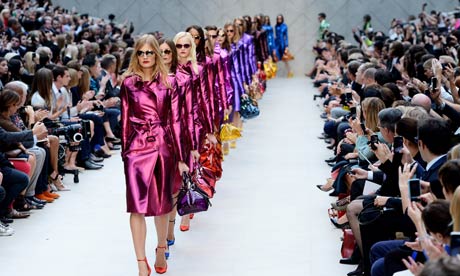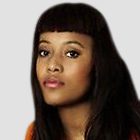Black models are still barely seen or heard – why has nothing changed?
Naomi Campbell is right to point out the lack of black faces on catwalks. London Fashion Week was a reminder of the problem

London Fashion Week. 'It has become a silent game for me over the past six years of attending various fashion weeks, to count the number of black models I see. As each one appears on the catwalk, I feel that pride and smile, almost telepathically screaming “WE ARE HERE!”' Photograph: Ian Gavan/Getty Images
A 12-year-old girl opens up a magazine and gazes over the pictures that make her strive to be beautiful. Those magnetic dresses and smiles gleaming on the paper, pulling you in, defining and teaching your young brain the age-old rules of aesthetics. She walks to the mirror and looks at her reflection, playing with her hair and pulling her face apart with the tips of her fingers hoping to mould herself into the "unattainable". But what do you see when you look into that mirror? Brown skin, brown eyes, full lips, curvy waist and that different shaped nose. No blonde hair and blue eyes. So does this mean I am not beautiful?
In 2010 I was selected to be one of the first black faces for a Marks & Spencer campaign. Many people in the industry questioned my motives. Being a musician and never having previously modelled, I was constantly asked "Why Marks & Spencer?" Only now can I fully understand the driving force that led me into the modelling world.
I began modelling because I was that young girl looking into the magazines and wondering why I didn't see more faces like mine looking back at me. Whatever tiny impact it made, I wanted to empower the young black women around me, to feel liberated at the inclusion of a black female in a high-profile British campaign.
After messages from young black women poured in once the campaign began, as well as feeling unbelievably humbled, my exasperation with the fashion industry felt validated.
This week Naomi Campbell launched a campaign to increase diversity on the catwalk, pointing out that over 82% of the model appearances at New York Fashion Week last year were by white women; just 6% were black. And, depressingly, saying the situation is worse than when she started modelling nearly three decades ago.
The discourse of race and self-identity is something that I feel extremely strongly about. I remember sitting in my sociology lectures and hearing of the infamous Clark doll experiment that surprised and profoundly worried me. The experiment, carried out in 1939, presented a black and a white doll to a group of black and white children and asked which doll they wanted to take home. A vast majority of black children chose the white doll (all the white children also chose the white doll).
The experiment was replicated in 1969, with similar results; further, the children described the discarded black dolls as "bad" or "ugly".
The experiment was done again in 2007, and the results were exactly the same. The negative association with the colour of skin was a clear sign that something was going very wrong in the children's psychological development. What had created the seemingly subconscious negative association with the colour of their own skin?
This week I've been sitting on the bafflingly sought-after front row at London Fashion Week. It has become a silent game for me over the past six years of attending various fashion weeks, to count the number of black models I see. As each one appears on the catwalk, I feel that pride and smile, almost telepathically screaming "WE ARE HERE!"
It's widely accepted that many designers, publications and catwalks do not want to use black models, claiming they don't sell their product. Have the few black models we do see become tokens at fashion shows?
Countless high-profile stories have been shared by black supermodels Naomi Campbell, Iman and Jourdan Dunn about the jaded perceptions of diversity in the fashion industry.
Excessive makeup is used to contour black features and lighten the skin to a more accessible "European" look. The general lack of understanding about the differences of black hair and makeup is often brought up, but then silenced for fear of questioning the artistic directors.
But the results of these attitudes have been manifesting themselves for all to see. This year international fashion magazine Numero used blonde-haired, blue-eyed Ondria Hardin in an editorial entitled African Queen. Hardin had been applied with full body bronzing make-up to emulate an African woman.
Why would a creative director choose to paint a white model in traditional "blackface"? Does this move render black models unnecessary; if jobs for "African Queens" are not being given to African women, what does that say about black models being disposable?
Interestingly, the former supermodel Tyra Banks recently curated a photographic exhibition centred on transforming herself into the world's biggest fashion icons, black and white. The controversial exhibition used "whiteface" – a black model becoming a white woman. Shots of Banks as models such as Cindy Crawford, Linda Evangelista, Jerry Hall, Iman, Kate Moss, Twiggy and Grace Jones were created with nothing more than intelligent lighting and makeup – no digital manipulation. Is Tyra Banks communicating that all black women are beautiful and deserve to be represented objectively, and celebrating the beauty of all races in fashion? Whatever the answer, this is a brave move and I commend her.
In the book Black Identity and Self-Esteem, Judith Potter and Robert Washington state: "Self-concept is in large a part of the social product, determined by the attitudes and behaviour towards the individual." Advertising evidently has a strong influence on this. Perhaps a shift in advertisement ethics will change things, or maybe not? But we need a change. The idea of the perfect dream should include everyone.
Just this week, we heard the outrage pouring from many Americans over the crowning of an Indian Miss USA.
Fashion is universal and should be presented as such, through varied perceptions of beauty. As supermodel Iman said of a diversity coalition in the fashion industry: "Silence is unacceptable".
The next time I sit at a fashion show, I hope to see a true representation of race and culture, beyond tokenism. I want my children to receive messages that tell them they are beautiful. Not have their identity overlooked with a fluster of fake smiles, feathers and "fabulous, darling".
